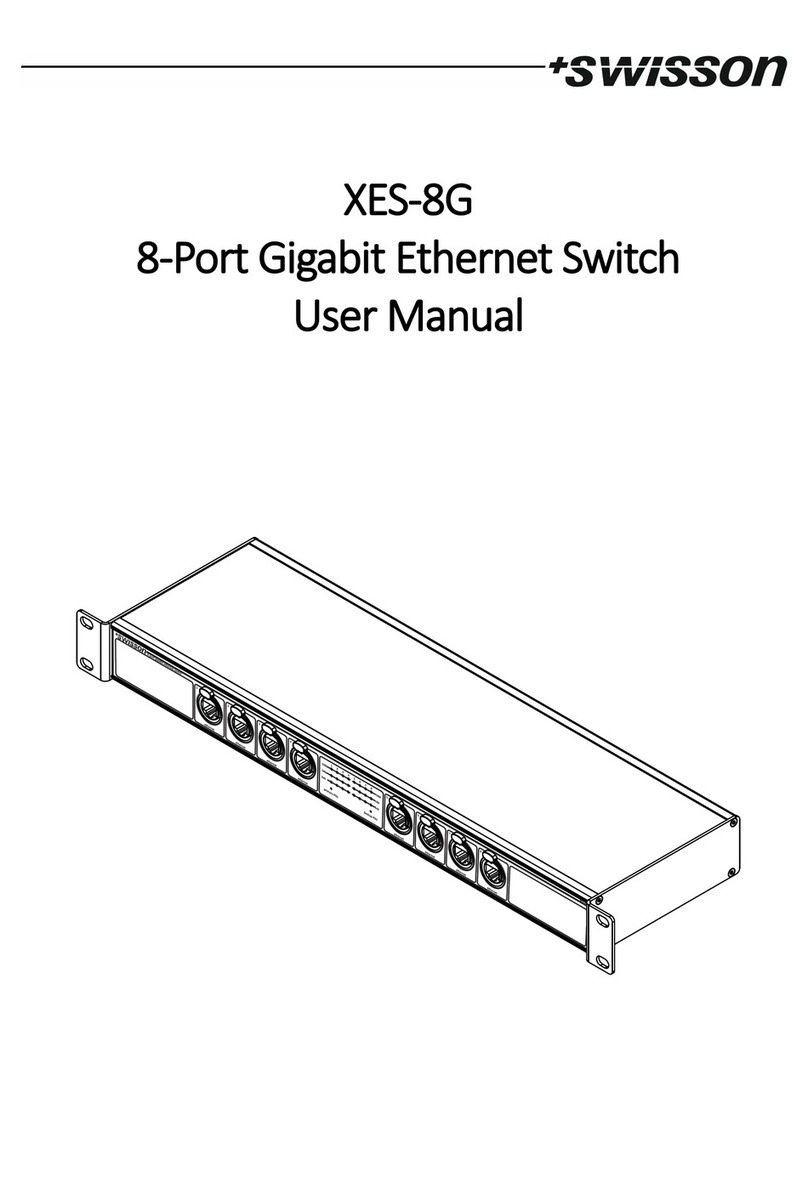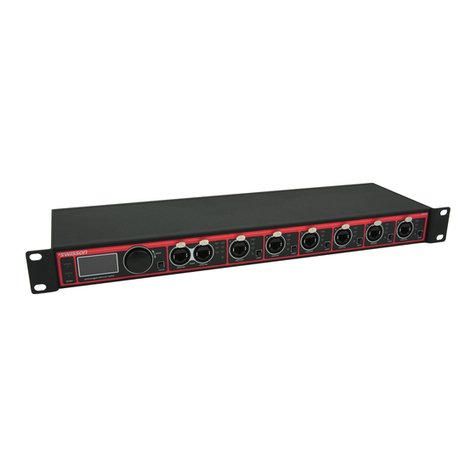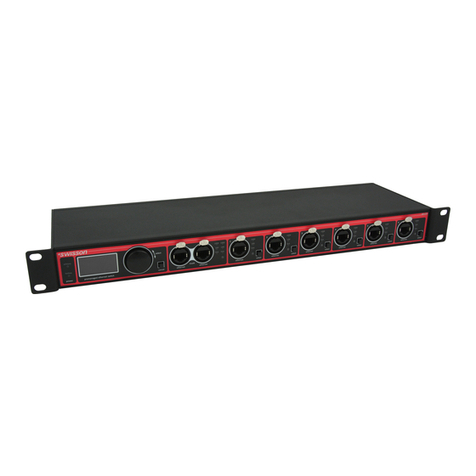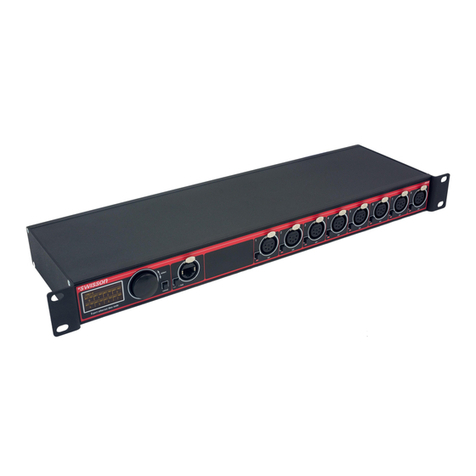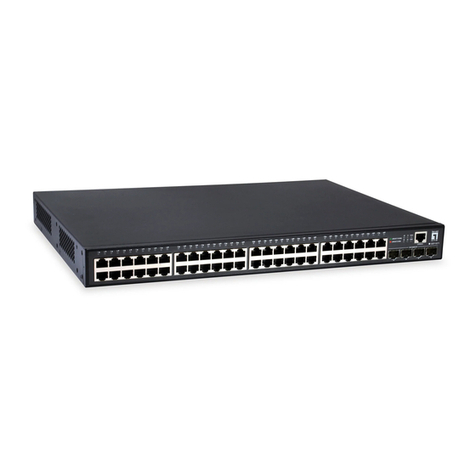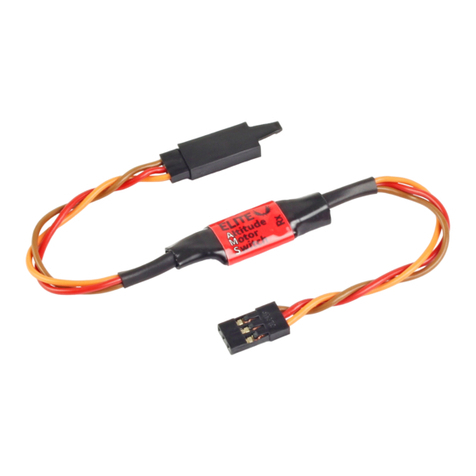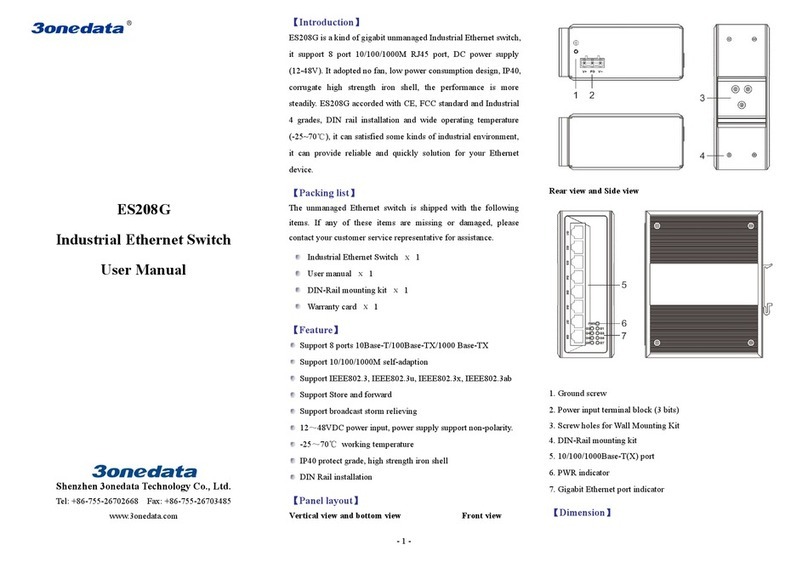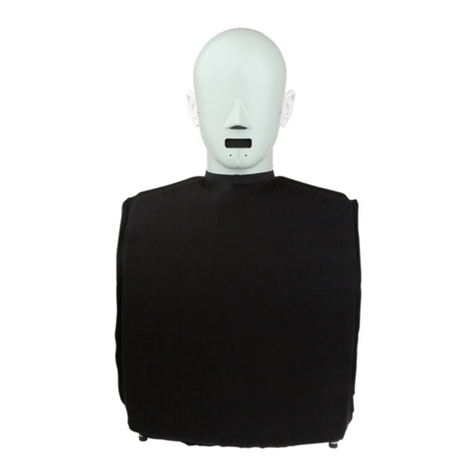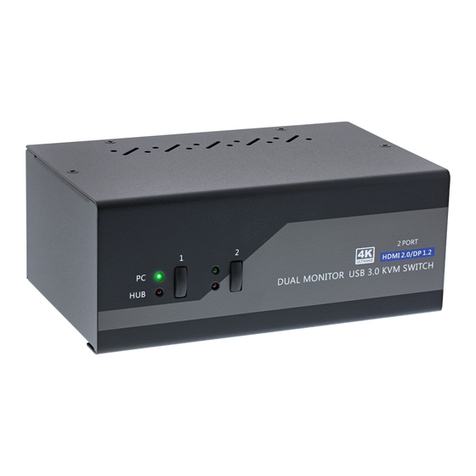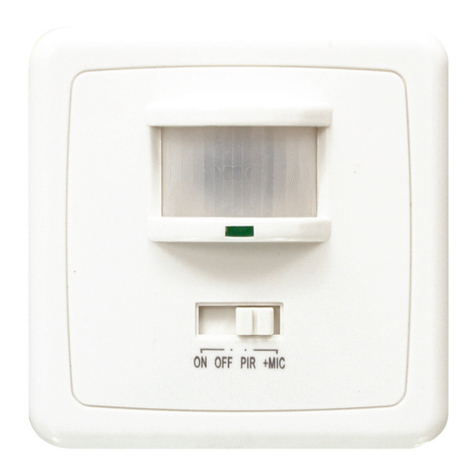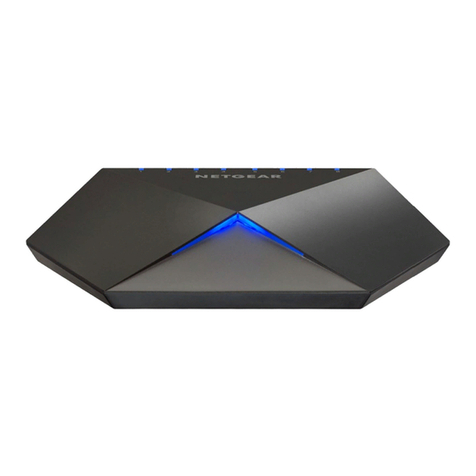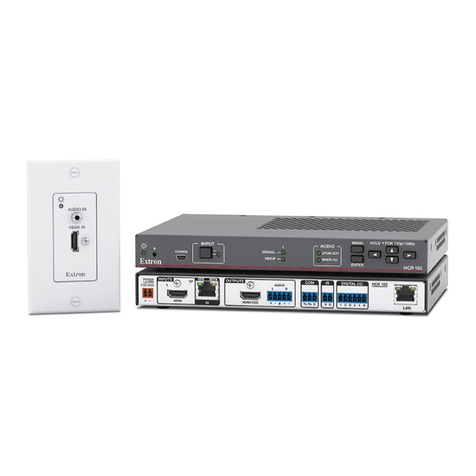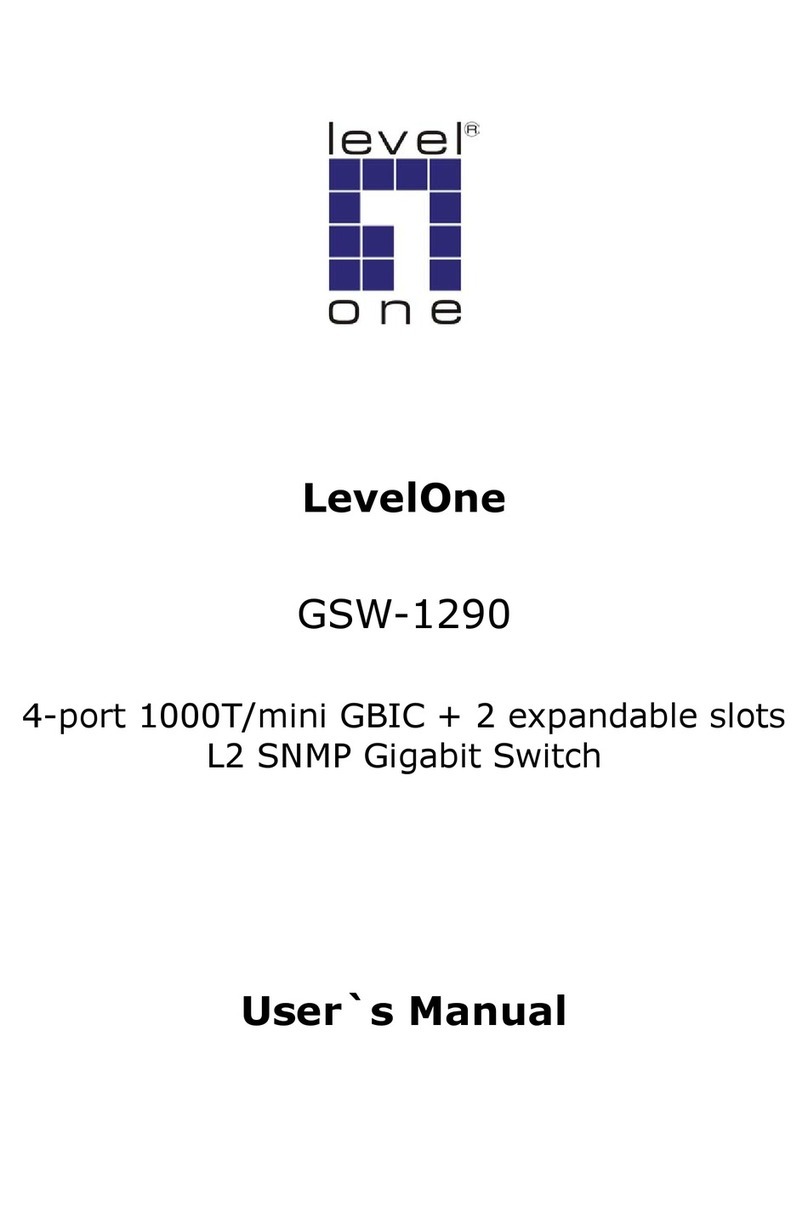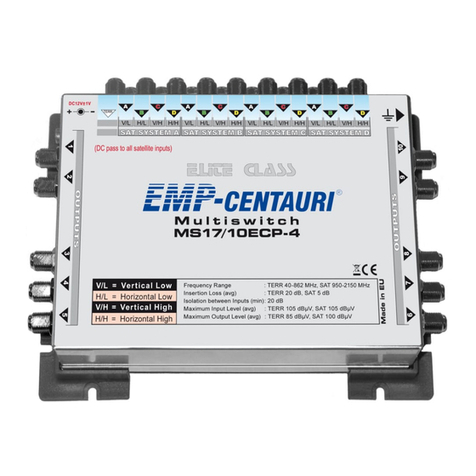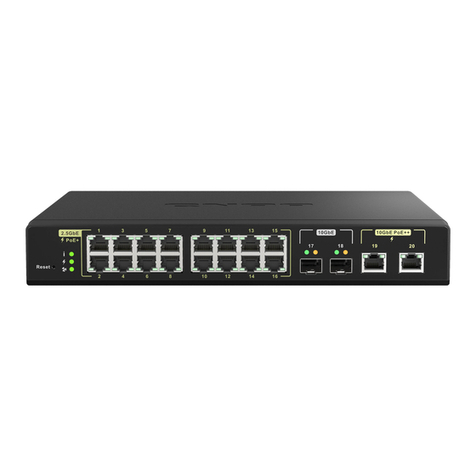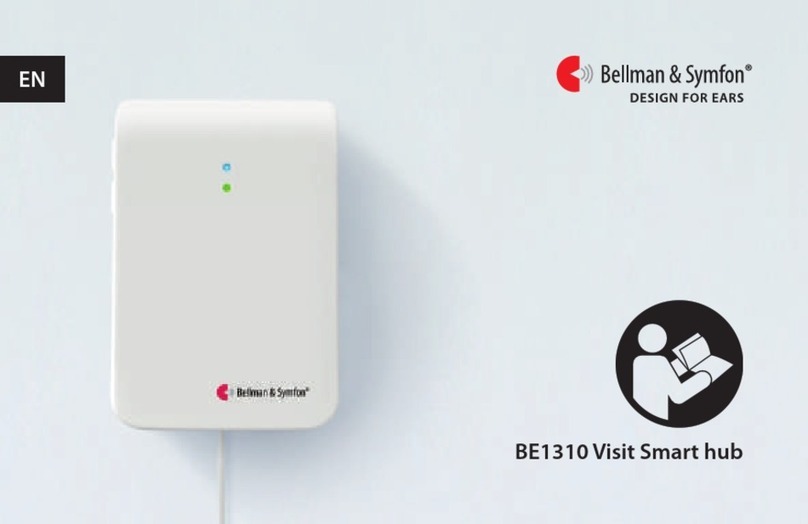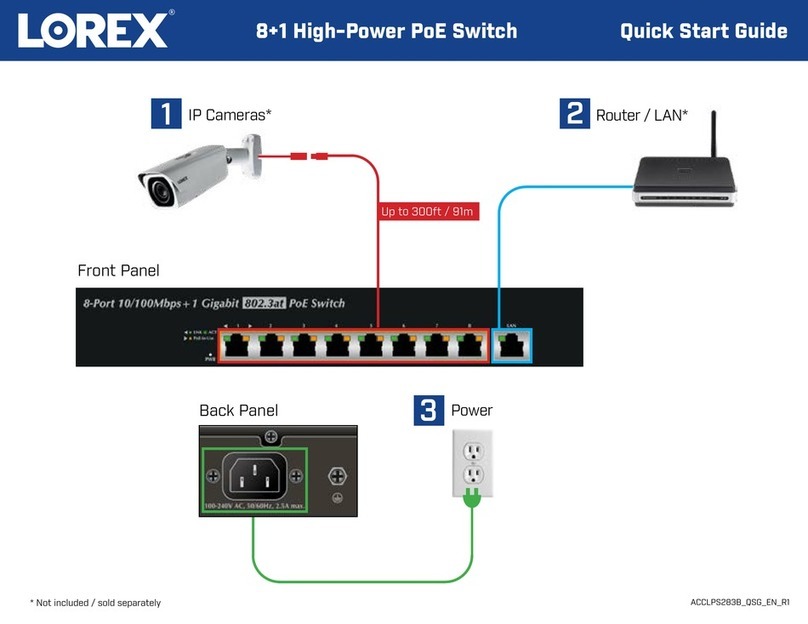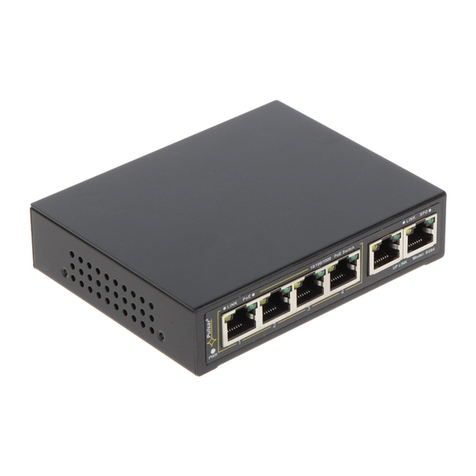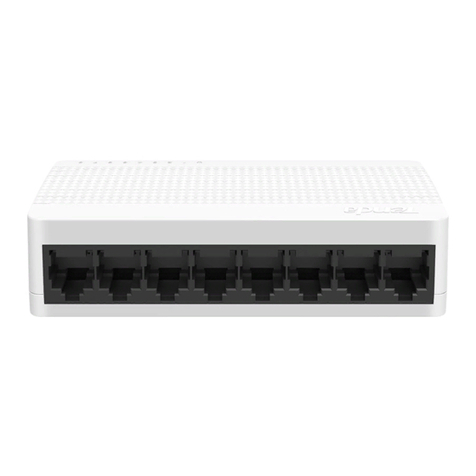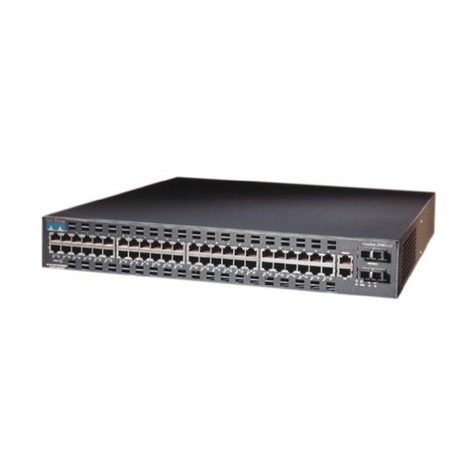Swisson XSP User manual

XSP / XSR
DMX Splitter &
RDM Hub
User Manual
USER MANUAL
LM-LOPSTER-DCAT-RCAT REV. 000

,

1
English
Description DateRevision
Revisions History
Copyright © 2012 SWISSON AG
First Draft 24.04.20121
E
D
Proofread 14.02.20141

The XSR and XSP series of RDM hubs and DMX splitter/boosters from
SWISSON can easily and economically be integrated into any lighting system
where it is desirable to split and boost DMX and RDM signals.
While the XSP splits and boost only DMX signals, the XSR also detects RDM
data and uses its bidirectional functionality to report back to the controller
(Lighting Board).
All output ports on both XSP and XSR are optically isolated. A strong power
supply allows for a reliable operation in a broad voltage range. A large program of
XSR and XSP devices is available, consisting of different housings, different
connector types and different numbers of input and output ports.
Introduction
XSRandXSP
DMXSplitter/Booster&
RDMHub
TV Sets
Theme Parks
Achitectural Lighting
Installations
Applications
Typical Application
DMXLightBoard
withorwithout
RDMfunctionality
DMX Fixtures
with or without
RDM functionality
DMX Dimmers
with or without
RDM functionality
The XSR works within DMX / RDM environments, but can also operate mainly in pure
DMX environments. The XSR is a good solution for those who expect to use RDM in
future, because the XSR acts as a normal DMX splitter if there is no RDM data.
The XSP works only within DMX evironments.
Concert Lighting
Live Events
Multimedia Shows
Theater
2
Unpacking
The DMX Splitter is packaged in a cardboard box. The following items are
included:
- The device
- This user manual
E

Safety Information
Consider the following notes mandatory when you set up, connect and use the
XSP / XSR.
This product is approved for professional use only, it is not intended for
household usage. Follow the safety instructions closely, when setting up,
connecting and using the device. Read the manual before operating the device
and pay attention to all the instructions or warnings given in this manual or
printed on the product.
Use this device only in accordance with local laws and regulations.
Safety Precautions
Disconnect the device from the AC power supply before removing any cover
or part, including fuse, even when not in use.
Ensure the device is electrically connected to ground (earth).
Use only a source of AC power supply that complies with local building and
electrical regulations and which has both overload and ground-fault (earth
fault) protection.
Connect the device to a AC power supply using the supplied power cable.
Before using the device, check that the power distribution equipment and
cables are in perfect condition and rated for the current required of all
connected devices.
Isolate the device from power supply immediately if the power cable or
power plug are in any way damaged, defective or wet, or if they show signs
of overheating.
Do not expose the device to rain or moisture.
Do not operate the device if any cover or component is missing, damaged or
deformed.
Refer any service operation not described is this manual to SWISSON AG.
Provide unrestricted airflow around the device.
Do not operate the device where the ambient temperature exceed 55 C
(131F)
Do not modify the device in any way other than described in this manual or
install other than genuine SWISSON parts.
Do not attempt to bypass the fuse. Replace defective fuse with one of the
specified type and rating only.
When suspending the device, ensure that the supporting structure and all
hardware used is capable to withstand at least 10 times the weight of all
devices suspended together.
Install as described in this manual, a secondary attachment such as a safety
cable that has been approved by an official body such as, e.g. TÜV (German
Technical Monitoring Association) as a safety attachment for the total weight
it secures. The safety cable must comply with EN 60598-2-17 Section 17.6.6
and be capable of bearing a static suspended load representing 10 times the
actual weight of the device.
Make sure that all external covers and rigging hardware are securely
fastened.
Provide clearance underneath the work area and a stable platform whenever
installing, servicing or moving an overhead device.
Do not use the device in areas where it is exposed to direct sunlight.
Do not use the device in areas that are considered to be 'highly inflammable'.
3
E

Boost
On installations with excessively long cable runs the DMX and/or RDM signal can
be compromised or significantly weakened by the distance.
good signal weak signal bad signal
The XSP/XSR boosts the signals thus eliminating signal interference encountered in
such situations.
good signal good signal
Regeneration
weak signal
In harsh environments DMX and RDM signals can be disturbed or corrupted.
good signal disturbed
signal
bad signal
The XSP/XSR cleans and regenerates the signals.
good signal good signaldisturbed
signal
disturbance disturbance
disturbance
Benefits of using a XSP/XSR Splitter / Booster
4
E

Splitting
A simple split of signal lines is not allowed. The bidirectional operation of RDM is
even more sensitive to the split than DMX.
not allowed
A split of the signal lines is possible with the XSR / XSP by using different output
ports.
Reduction of Reflection Problems
Signal reflection is a common problem in large DMX installations or on long signal
lines. The bidirectional operation of RDM is more sensitive to reflections than
DMX.
Weak
reflection
with large
delay.
Signal OK
Strong
reflection
with large
delay.
Bad signal !
Strong
reflection
with small
delay.
Signal OK
Reflection
with small
delay.
Signal OK
Reflection
with small
delay.
Signal OK
The XSP/XSR splits the line into smaller segments with a regenerated signal,
which reduces the delay of the reflection at each segment.
5
E

Protection
The XSP/XSR separates the line into multiple segments. The over voltage is
restricted to the concerned segment. The XSP/XSR itself is well protected
against transient over voltage and the optical isolation of each port prevents a
damage to other ports and segments in case of a permanent over voltage.
In case of an over voltage on the DMX and RDM line(s), all devices on that line
can be damaged.
Protection
Transmitter
ProtectionProtectionProtection
Protection
Optical
Isolation
Control Logic
Protection
Receiver
Out Port 5
Out Port 4
Out Port 3
Out Port 2
Out Port 1
In Port Thru Port
Line
Termination
Termination
TransmitterTransmitter
TransmitterTransmitter
XSP Block Diagram
6
E
Optical
Isolation
Optical
Isolation
Optical
Isolation
Optical
Isolation

Protection
Transceiver
Optical
Protection
ProtectionProtection
Protection
Transceiver
Transceiver
Transceiver
Transceiver
Optical Optical Optical Optical
Control Logic
Protection
Transceiver
Out Port 5
Out Port 4
Out Port 3
Out Port 2
Out Port 1
In Port Thru Port
Line
Termination
Termination
DMX Only
XSR Block Diagram
Mains Connection
Two different mains connections are available:
The US versions are delivered by SWISSON with an "Edison Plug" (NEMA-5-15).
These models carry a "-US" suffix at the end.
The international versions are supplied plugless.
SWISSON distributors or dealers may deliver the devices with a country specific
plug.
US Versions (-US suffix) International Versions
Brown : Phase Blue : Neutral
Yellow/Green : Earth
7
Neutral
Live
Wire (US System)
Ground (Earth)
Wire (EU System) Symbol
L
N
or
black
white
green
brown
blue
yellow/green
Consult a qualified electrician if you have any doubts about
proper installation.
The socket where the device is plugged in must be close to
the device and easy to access.
E

The Input section of the versions with terminals:
The “input” and “thru” terminals are located on the back of the device.
Input Section XSR Versions
The Input section of the XSR versions with XLR connectors
The Input section of the XSR versions with terminals:
The “input” and “thru” terminals are located on the back of the device.
The Power LED indicates if the device is powered and if the
power supply unit of the XSP is working.
A green LED indicates if a signal is available at the Input port.
A red LED indicates if the received signal is faulty.
The XSP has a built-in line termination. This can be activated by
pressing the termination button. A LED indicates if the termination is
activated.
8
Input Section of XSP Versions
The Input section of versions with XLR connectors
E

The RDM LED indicates if RDM data packets are preset. In a pure DMX
environment this LED remains in OFF state.
The XSR has a built-in line termination. This can be activated by
pressing the termination button. A LED indicates if the termination is
activated.
The "DMX only" function of the XSR allows removal of all RDM data
from the Output ports. A LED indicates if the "DMX only" function is
activated.
Input and Thru Port
Protection Transceiver
Line
Termination
InputPort ThruPort
The THRU port is hardwired with the INPUT port and allows to daisy-chain the
devices, even when the XSR is not powered. On all XSP and XSR models with a
5-Pin XLR connector the pin 4 and 5 are also looped through to the THRU port.
On all other models pin 4 & 5 are not available.
1
2
3
4
5
1
2
3
4
5
9
RDM Identify
Blinking of all Output LEDs: The RMD Identify is activated.
Errors
Blinking of “DMX only” LED: Error UID not valid. RDM operation is not
possible. DMX operation only.
Blinking of all LEDs (except power and termination LED): Fatal error
A multicolor LED indicates if a signal is available at the Input port. The LED
has 2 different states:
Green: Signal is present and Ok
Red: No signal is present or signal is present but faulty
The Power LED indicates if the device powered and if the power supply
unit of the XSR is working.
E

DMX Only (only on XSR models)
The "DMX only" function removes all non DMX data before sending the data to
the Output ports. RDM data will be removed too.
This can be helpfull when DMX devices are not compatible and do not check the
data they receive as valid DMX signals.
The "DMX only" function is activated by pressing the "DMX only" button. On
terminal and Installation versions, the button is only accessible with a tool.
Output Ports
The output section of
versions with XLR
connectors:
The OUTPUT section
of versions with
terminals:
The OUTPUT
terminals are located
on the back of the
devices.
Each Output port is individually optically isolated, meaning that it is totally isolated
from the other Output ports and the Input selection.
The Pins 4&5 on models with 5-Pin XLR connectors are not connected.
10
Line Termination
All XSP and XSR splitters have a built-in line termination. The termination is
activated by pressing the termination button. On terminal and Installation versions
the button can only be accessed using a tool (such as a paper clip).
E

XSP / XSR Box Models
Mains cable
M10 female threat for clamp
Ring for safety wire
cable length approx. 145cm
217.5mm
Mains plug (US-Versions only)
112mm
45mm
11
Output
Port
1
2
3
4
5
Protection
Transceiver
Optical
Isolation
Port Supply
Control
Logic
Controller Supply
n.c.
Bias
Network
On the XSR, the indicator LED of the OUTPUT ports indicates if a valid
signal is transmitted. It works bidirectionally:
When sending DMX or RDM packets and when receiveing RDM
responses.
This LED is not available on XSP models.
The M10 screw which enters the XSP/XSR should not exceed a maximum length
of 20mm.
Clamp is not included with the XSP/XSR.
20mmMAX
E

Single Rack Models
482mm
112mm
45mm
cable length approx. 145cm
Mains plug (US-Versions only)
Double Rack Models
482mm
112mm
45mm
cable length approx. 145cm
Mains plug (US-Versions only)
12
E

Single Rack Terminal Models
Double Rack Terminal Models
482mm
112mm
45mm
482mm
112mm
45mm
13
E

Terminal Models
The terminal models of the XSP/XSR series come with pluggable terminal blocks.
The terminal blocks are located on the back of the devices.
XSP/XSR terminal models are shipped with the terminal blocks. They can accept
2
wires up to AWG 17 (~1mm )
Installation Models
The XSP/XSR installation model is manufactured to be installed by certified
professionals. This version has no plugs. The connections are all located inside
the device.
Mains
grommet
Output ports
Thru port
Input port
cover
14
E

XSP Standard Program
10 11 63 XSP-3B
11 11 63 XSP-3B-US (with NEMA 5-15)
10 11 74 XSP-3R
11 11 74 XSP-3R-US (with NEMA 5-15)
Front view
Rear view
Front view
Rear view
10 11 85 XSP-3R-3R
11 11 85 XSP-3R-3R-US (with NEMA 5-15)
Front view
Rear view
10 11 62 XSP-5B
11 11 62 XSP-5B-US (with NEMA 5-15)
Front view
Rear view
10 11 72 XSP-5R
11 11 72 XSP-5R-US (with NEMA 5-15)
Front view
Rear view
10 11 82 XSP-5R-5R
11 11 82 XSP-5R-5R-US (with NEMA 5-15)
Front view
Rear view
15
E

10 11 60 XSP-5B5
11 11 60 XSP-5B5-US (with NEMA 5-15)
Front view
Rear view
10 11 70 XSP-5R5
11 11 70 XSP-5R5-US (with NEMA 5-15)
Front view
Rear view
10 11 80 XSP-5R5-5R5
11 11 80 XSP-5R5-5R5-US (with NEMA 5-15)
Front view
Rear view
10 11 87 XSP-5R2-5R2
11 11 87 XSP-5R2-5R2-US (with NEMA 5-15)
Front view
Rear view
10 11 84 XSP-5R-5R5
11 11 84 XSP-5R-5R5-US (with NEMA 5-15)
Front view
Rear view
10 11 86 XSP-5R-3R
11 11 86 XSP-5R-3R-US (with NEMA 5-15)
Front view
Rear view
16
E

OUT 1OUT 2OUT 3OUT 4OUT 5 INTHRU
10 11 50 XSP-TR5
11 11 50 XSP-TR5-US (with NEMA 5-15)
Front view
Rear view
10 11 51 XSP-TR5-TR5
11 11 51 XSP-TR5-TR5-US (with NEMA 5-15)
Front view
Rear view
OUT 1OUT 2OUT 3OUT 4OUT 5 INTHRU OUT 1OUT 2OUT 3OUT 4OUT 5 INTHRU
10 11 98 XSP-IB5-W
Front view
Rear view
XSR Standard Program
10 12 10 XSR-3B
11 12 10 XSR-3B-US (with NEMA 5-15)
10 12 20 XSR-3R
11 12 20 XSR-3R-US (with NEMA 5-15)
Front view
Rear view
Front view
Rear view
10 12 30 XSR-3R-3R
11 12 30 XSR-3R-3R-US (with NEMA 5-15)
Front view
Rear view
17
E

Front view
Rear view
10 12 21 XSR-5R
11 12 21 XSR-5R-US (with NEMA 5-15)
Front view
Rear view
10 12 31 XSR-5R-5R
11 12 31 XSR-5R-5R-US (with NEMA 5-15)
Front view
Rear view
10 12 16 XSR-5B5
11 12 16 XSR-5B5-US (with NEMA 5-15)
Front view
Rear view
10 12 26 XSR-5R5
11 12 26 XSR-5R5-US (with NEMA 5-15)
Front view
Rear view
10 12 33 XSR-5R5-5R5
11 12 33 XSR-5R5-5R5-US (with NEMA 5-15)
Front view
Rear view
10 12 11 XSR-5B
11 12 11 XSR-5B-US (with NEMA 5-15)
18
E
This manual suits for next models
1
Table of contents
Other Swisson Switch manuals
